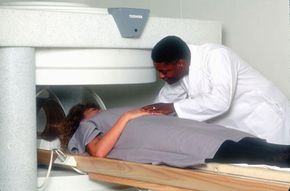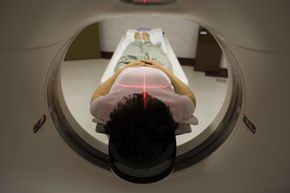Magnetic resonance imaging (MRI) provides an unparalleled view inside the human body. The level of detail that MRI provides is extraordinary. It's the method of choice for the diagnosis of many types of injuries and conditions because of the incredible ability to tailor the exam to the particular medical question being asked.
The biggest and most important component in an MRI system is the magnet. The magnet is rated using a unit of measure known as a tesla. Another unit of measure commonly used with magnets is the gauss (1 tesla = 10,000 gauss). The magnets commonly used today in MRI are in the 0.5-tesla to 3.0-tesla range, or 5,000 to 30,000 gauss. Magnetic fields greater than 3 tesla haven't been approved for use in medical imaging, though much more powerful magnets -- up to 60 tesla -- are used in research. Compared with the Earth's 0.5-gauss magnetic field, you can see how incredibly powerful these magnets are.
Advertisement
Because of the power of these magnets, the MRI suite can be a very dangerous place if strict precautions aren't observed. Metal objects can become dangerous projectiles if they are taken into the scan room. For example, paperclips, pens, keys, scissors, hemostats, stethoscopes and any other small objects can be pulled out of pockets and off the body without warning, at which point they fly toward the opening of the magnet (where the patient is placed) at very high speeds, posing a threat to everyone in the room. Credit cards, bankcards and anything else with magnetic encoding will be erased by most MRI systems.

